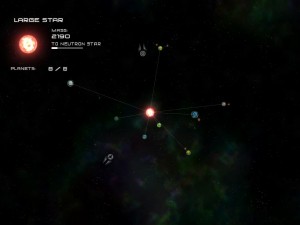Solar 2
 Solar 2 is a 2D game that puts you in the role of a heavenly body — first an asteroid, later a planet or star. As the game’s blurb puts it: “In most games you see stars in the background, you shoot asteroids or you live on planets. But in Solar 2 you ARE these objects!” — which is a little disingenuous, because in fact you see stars in the background here as well; it uses a static starfield-with-nebulas image to provide a sense of motion when you go zooming around the vast depths of space. Which is something you can do. Unlike all the other stars and asteroids and so forth you encounter, you scoff at Newton’s laws and roam about under your own power, like the little spaceships sometimes found near life-bearing planets, blasting apart asteroids that get too close.
Solar 2 is a 2D game that puts you in the role of a heavenly body — first an asteroid, later a planet or star. As the game’s blurb puts it: “In most games you see stars in the background, you shoot asteroids or you live on planets. But in Solar 2 you ARE these objects!” — which is a little disingenuous, because in fact you see stars in the background here as well; it uses a static starfield-with-nebulas image to provide a sense of motion when you go zooming around the vast depths of space. Which is something you can do. Unlike all the other stars and asteroids and so forth you encounter, you scoff at Newton’s laws and roam about under your own power, like the little spaceships sometimes found near life-bearing planets, blasting apart asteroids that get too close.
The way that the spaceships go about their own asteroid-demolition and largely ignore you combines with the free roaming in a very large 2D environment to make it feel at times like a much more relaxed version of Sinistar. The way you grow by accretion, first by ramming into asteroids and later by pulling in planetoids that have gone into orbit around you, is a little Katamari-ish, particularly if you decide to take it to its limit and become a universe-devouring black hole. But, oddly enough, the game that it reminded me of the most is the original Grand Theft Auto. And that’s because of the missions.
Missions are assigned by a godlike disembodied voice (presented in text boxes, not voice acting), which sometimes interrupts partway through a mission to assign new goals, or even just to make snarky comments. A typical mission might involve destroying a particular planet, or drawing another planet to a particular location by tugging it with your gravity, or surviving waves of attacking spaceships, or dodging as the godlike voice throws a bunch of stars at you at high speed. When there’s a particular place you need to go, the familiar GTA-style quest arrow points the way. The voice’s narration provides silly pretexts for them all: the asteroid you’re trying to make bigger is an old friend, the planet that you have to decide whether to destroy or defend is populated entirely by kittens, etc. There’s a touch of GLaDOS in its fantasies.
There are three sets of missions: one set for when you’re an asteroid, another for when you’re a planet, and a third for when you’re a star. (I wasted some time after I first turned into a planet by restarting to see the Asteroid missions I hadn’t seen yet. This is unnecessary; although there’s no in-game way to go back to earlier stages, you can do so through the main menu without losing your progress.) You actually go through more stages than these three — a neutron star, for example, or a life-bearing planet with your own fleet of defensive spaceships — but these sub-forms do not get distinct missions. Black holes get just one mission, assigned automatically, but all other stages get a choice of several.
How do you indicate your choice? More quest arrows! Whenever you’re not engaged in a mission, some arbitrary circles of space are assigned to be mission start points, with an arrow pointing to each. And I really do mean “arbitrary”. There’s no permanent terrain in this game, so there’s no particular mission-receiving place. The mission start points are just arranged around wherever you are, and have no particular relationship to the missions. Frequently the first stage in a mission is just to go someplace else. But you have to go to the mission start to be told where.
There’s no real in-game logic for this means of assigning and choosing missions. There are, however, two points of convenience: it requires no additional mechanics beyond what’s already been established for directing the player to locations, and it’s basically familiar to a large portion of the audience from its similarity to GTA. Instead of arbitrary circles placed dynamically in space, GTA used statically-placed pay phones, but the principle was the same. Whenever you weren’t in a mission, you got a quest arrow for each phone that had a mission for you. Choosing your mission by choosing which phone to pick up didn’t really make much more sense there than in Solar 2, but by grounding it in something concrete, it masked the arbitrariness a little better. Solar 2, using the same mechanic, makes it obvious how illogical it always was.
 Comments(0)
Comments(0)